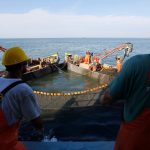Salmon reared on special fish feed diets by the Skretting Aquaculture Research Centre in Norway were eaten by pregnant women in England in the first ever intervention study of the potential benefits for pregnant women of eating oily fish. The study was part of the EU-funded AquaMax project.
The University of Southampton team that ran the study concluded that there were measurable nutritional benefits for the women and their newborn babies. These continue after birth if the baby is breast fed. The study was part of the EU-funded AquaMax project, which ran from 2006 until mid 2010.
Philip Calder, Professor of Nutritional Immunology at the Medical School of Southampton University led the team. “There are many reports of the benefits of eating oily fish such as salmon, mainly associated with the long-chain omega-3 polyunsaturated fatty acids EPA and DHA, vitamin D and selenium. Our ‘Salmon in Pregnancy Study’ was the first time anyone had stipulated a different diet for two groups of pregnant women and looked for the differences in their blood.”
Over 2,000 kg of salmon were reared with a diet that ensured the fish would have a good content of the nutrients under investigation. Fillet portions of 150 g were frozen individually in vacuum seal bags for transport to Southampton, where they were stored until needed. Analysis at the National Institute of Nutrition and Seafood Research in Norway showed each portion contained 30.5 g protein, 16.4 g fat, 1.7 g marine omega-3 fatty acids as well as a good content of vitamin D and selenium. Two fillets a week provided more than the recommended minimum intake of EPA and DHA; substantially more than the amount usually eaten by most young women in the UK.
Professor Calder continues, “We recruited 120 women who did not regularly eat oily fish and divided them into two groups of 60. One group continued their normal diet and the other group ate salmon twice a week from week 20 of their pregnancy. We measured the levels of the EPA, DHA, vitamin D and selenium in blood samples and found significant differences, with the levels being higher in the salmon group. Levels of DHA and EPA declined during the pregnancy in the non-salmon group and increased with the salmon eaters. DHA is an important structural component of the eye and nervous system, including the brain. These organs develop during the growth of the foetus and in early life. The DHA is provided by the mother, either through the blood supply to the foetus or in breast milk following the birth. Eating these salmon could make an important contribution to the early growth and development of the babies.”








